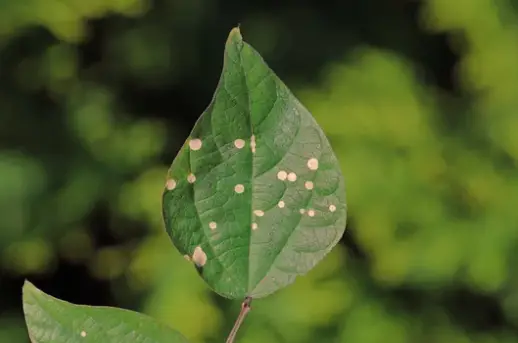White spots on bean leaves can be a cause for concern among farmers and gardeners.
These spots not only affect the visual appeal of the plants but can also indicate underlying issues that may impact the overall health and yield of the crop.
In this blog post, we will delve into the causes, identification, and remedies for white spots on bean leaves, equipping you with the knowledge needed to maintain thriving bean plants.
What Are White Spots on Bean Leaves?

White Spots on Bean Leaves
White spots on bean leaves are characterized by the presence of small, light-colored patches on the leaf surface.
These spots can vary in size, shape, and texture, and may appear powdery, fuzzy, or crusty. Powdery mildew, a common fungal infection, often manifests as white, powdery spots on the upper surface of the leaves.
On the other hand, downy mildew appears as yellowish or grayish patches with a downy or fuzzy texture on the undersides of the leaves.
Potential Causes
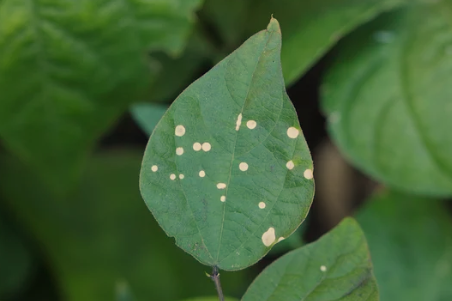
Fungal Infections:
Fungal infections, such as powdery mildew or downy mildew, are common culprits behind white spots on bean leaves.
These infections thrive in warm, humid conditions, making bean plants susceptible to their growth and spread.
Fungi reproduce by releasing spores, which are often carried by wind or water. Once the spores land on the leaves, they germinate and grow, leading to the formation of white spots.
The white spots associated with fungal infections are typically powdery in texture and can spread rapidly if left untreated.
Insect Infestations
Certain insects, including spider mites and aphids, can cause damage to bean leaves, leading to the formation of white spots.
These pests feed on the plant tissues, leaving behind marks and discoloration. Spider mites, for example, puncture the leaf cells and extract sap, resulting in small, whitish, or yellowish spots.
Aphids, on the other hand, feed by sucking the plant’s fluids, causing the affected areas to turn pale or yellowish.
The presence of white spots resulting from insect infestations often coincides with other symptoms, such as leaf curling or distorted growth.
Nutritional Deficiencies
White spots on bean leaves can also indicate nutritional deficiencies, particularly calcium or magnesium deficiencies.
Calcium plays a vital role in cell wall development and strength, while magnesium is essential for chlorophyll production.
When these essential nutrients are lacking, it affects the plant’s metabolic processes, leading to leaf abnormalities.
Calcium deficiency often results in the formation of small, necrotic spots surrounded by a white halo.
Magnesium deficiency, on the other hand, leads to interveinal chlorosis, where the areas between the veins turn yellow while the veins remain green.
Identifying White Spots on Bean Leaves
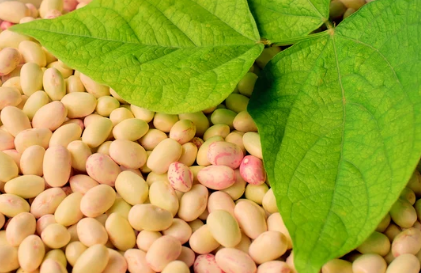
A. Visual Examination: To identify white spots on bean leaves, begin by visually inspecting the foliage.
Look for small patches that stand out against the healthy green color of the leaves.
Note the size, color, and distribution of the spots, as these can provide valuable clues about the underlying cause.
In the case of fungal infections, the white spots are often confined to the upper leaf surface and may exhibit a powdery texture.
Insect-induced white spots may vary in shape and size, depending on the feeding patterns of the specific pests.
Diagnostic Tools
In some cases, visual examination alone may not be sufficient. Employing magnifying lenses or digital microscopes can aid in a more detailed analysis of the spots.
This allows for a closer look at the texture, presence of fungal spores, or signs of insect activity.
Furthermore, there are smartphone apps and online resources available that provide assistance in diagnosing leaf diseases based on visual cues.
These tools can be helpful in confirming the suspected cause and guiding appropriate treatment measures.
Differentiating Causes
Understanding the distinct characteristics associated with different causes is crucial for accurate identification.
Fungal infections often exhibit a powdery texture, and the spots may coalesce to cover larger areas of the leaves. Common symptoms of fungal infections include stunted growth, leaf distortion, and premature defoliation.
Insect damage, on the other hand, may result in irregularly shaped spots, often accompanied by visible bite marks or discolored areas.
Nutritional deficiencies may present as isolated white spots with specific patterns, such as interveinal chlorosis or necrotic areas with white halos.
Remedies and Preventive Measures:
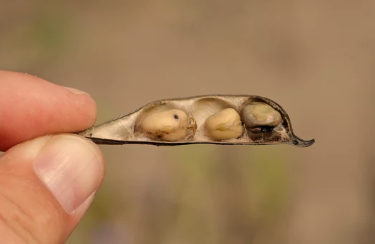
Cultural Practices
Implementing good cultural practices is an essential step in preventing white spots on bean leaves. Proper sanitation plays a vital role in disease management.
Remove and destroy any infected leaves to prevent the spread of fungal infections. Additionally, maintaining appropriate plant spacing allows for better air circulation, reducing the chances of fungal growth.
Avoid overhead watering, as it creates a favorable environment for fungal spores to germinate and infect the leaves.
Chemical Controls
In cases where fungal infections or insect infestations have taken hold and cultural practices alone are not sufficient, chemical controls may be necessary.
Fungicides or insecticides formulated specifically for the identified pests can help combat the problem effectively.
It is vital to carefully follow label instructions, apply these products judiciously, and consider organic alternatives if available.
Remember to consider the potential impact on beneficial insects and pollinators and use chemical controls as a last resort.
Nutritional Management
Addressing nutritional deficiencies is crucial for preventing white spots on bean leaves caused by imbalances. Regular soil testing helps identify any deficiencies and allows for appropriate fertilization.
Adding organic matter, such as compost, to the soil improves nutrient retention and availability.
In the case of calcium or magnesium deficiencies, incorporating lime or dolomite into the soil can help raise the pH and provide a steady supply of these minerals.
Resistant Varieties
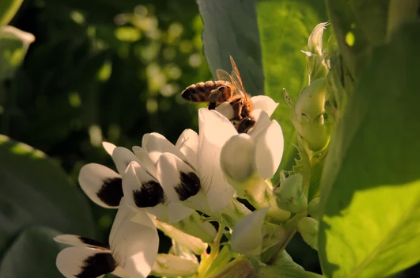
Selecting and cultivating bean varieties that are resistant to specific fungal diseases or insects is a proactive approach to preventing white spots. These varieties have inherent traits that make them less susceptible to common pests and diseases.
Consult local agricultural extension services or seed suppliers to identify suitable resistant varieties for your region. Planting resistant varieties reduce the reliance on chemical controls and contribute to long-term sustainable farming practices.
Conclusion
White spots on bean leaves should not be overlooked, as they can signal underlying issues that impact the health and productivity of the plants.
When you understand the causes, identify the spots accurately, and implement the appropriate remedies, you can maintain healthy bean plants and ensure a successful harvest. Remember to adhere to good cultural practices, consider chemical controls when necessary, manage soil nutrition, and explore resistant varieties.
By taking these steps, you’ll be well-equipped to tackle white spots and keep your bean plants thriving year after year.

